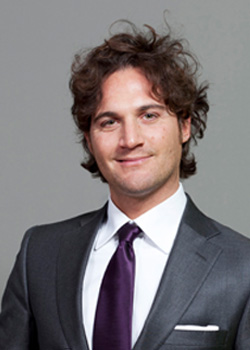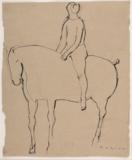Marino Marini *

(Pistoia 1901–1980 Viareggio)
Piccolo Miracolo, 1955–56, signed M. M. under the base, bronze, 44.1 x 41.5 x 14 cm
Provenance:
Sale Farsetti, Prato, 29 November 2008, lot 750
European Private Collection
Exhibited:
Venice, Marino Marini-Sculture pitture, disegni dal 1914 al 1977, Palazzo Grassi, 28 May – 15 August 1983, exh. cat. p. 145, no. 91, another example exhibited
Ascona, Marino Marini, Museo Comunale d’Arte Moderna, 3 September – 29 October 1989, another example exhibited
Bologna, Marino Marini, Forni Galleria d’Arte, October 1990, exh. cat. p. 51, another example exhibited
Rome, Marino Marini-Antologica 1919–1978, Villa Medici, 7 March – 19 May 1991, exh. cat. p. 100, another example exhibited
Paris, Marino Marini, Galerie Philip, October – December 1993, exh. cat. no. 7, another example exhibited
Verona, Marino Marini. Mitografia-sculture e dipinti 1939–1966, 11 December 1994–12 February 1995, exh. cat. p. 93, no. 25, another example exhibited
Tokyo, Marino Marini, Station Gallery, 22 November 1997– 25 January 1998, exh. cat. p. 39, no. 17, another example exhibited
Literature:
P. Waldberg, H. Read, G. di San Lazzaro, Marino Marini Complete works, New York 1970, p. 373, no. 333, another example ill.
C. Pirovano, Marino Marini, Scultore, Milan 1972, no. 339, another example ill.
M. P. Garberi, Marino Marini alla Galleria d’Arte Moderna di Milano, ed. Comune di Milano, Milan 1973, no. 29, another example ill.
M. P. Garberi, Marino Marini alla Galleria d’Arte Moderna di Milano, A. Mondadori (ed.), Milan 1984, p. 163, no. 31, another example ill.
M. Meneguzzo, Marino Marini-Cavalli e Cavalieri, Skira (ed.), Milan 1997, p. 226, no. 85, another example ill.
M. Meneguzzo, Marino Marini-Il Museo alla Villa Reale di Milano, Skira (ed.), Milan 1997, no. 29, another example ill.
Fondazione Marino Marini (ed.), Marino Marini, Catalogue Raisonné of the Sculptures, Milan 1998, p. 288, no. 414, another
Location of the remaining six examples:
Milan Galleria d’Arte Moderna, Museo Marino Marini
Pistoia, Palazzo del Tau, Fondazione Marino Marini (no legs-variant)
Toyota-City, Municipal Museum of Art (no legs-variant in polychrome bronze)
The three other examples are in Private Collections (one of which is a no legs-variant)
This work is one from an edition of 7 examples
This work is registered in the Archivio Fondazione Marino Marini and is accompanied by a photo certificate of authenticity
What fascinated Marino Marini most was Etruscan bronze sculpture. For Marini, returning to Italic art was the only way to understand the origins of sculpture, but above all, to rediscover the origins of his land, Tuscany, and his ancestors, thus reinterpreting classical art in a modern vein.
“I look to the Etruscans for the same reason that all modern art has looked to the past, traversing the immediate past and pushed to reinvigorate itself in the most authentic expression of a virgin and remote humanity. This is not just a cultural coincidence, but how we aspire to a simplicity of art” (Statement to Il Sud Attualità newspaper, on the occasion of the 1948 Biennale).
Marini was able to measure himself simultaneously against Picasso, Gothic sculpture, Henry Moore, Renaissance portraiture, Rodin and Maillol, and the art forms of the most distant continents. The distinctive feature of his art was precisely this ability to use the historical testimony, his cultural roots, and the links with an ancestral past to create contemporary art in dialogue with the present that fully participated in the revolutions of his time. His sculpture, like most of the creative acts of 20th century artists and intellectuals, is thus set within the dense web of events linked to world conflicts and their relationship with humanity.
The work analysed here belongs to the series of 7 pieces known as “Miracoli” (Miracles): a typical theme of Marino Marini’s sculpture from 1943 onwards - the year he fled to Switzerland to escape the bombings of the Second World War.
The theme of horse and the rider is one of the leitmotifs of Marini's sculpture and in the “Miracles” he has tried to maintain the two subjects, but heightening them in a series of versions where the horse always subjugates the rider: a metaphor for humanity wounded by the tragedies of war.
He himself defines the Miracles as follows: “The rider becomes more and more incapable of mastering his horse, and the beast, in its increasingly fierce anxiety, becomes rigid instead of rearing up. I really believe we are heading for the end of the world”.
The horse, untamed and reckless, is out of the control of its rider, who is caught at the point where he is about to fall to the ground without any chance of getting up.
The composition of this sculpture is so simple as to make the two subjects, horse and rider, a single sculptural body in which everything seems charged with tension and the rider appears to be trying, in vain, to get up again.
Marino Marini's uniqueness lies in his ability to imprint on the bronze all the expressiveness and tension of the scene, so much so that those who contemplate this sculpture perceive an apocalyptic atmosphere with no possible remedy.
Specialist: Alessandro Rizzi
 Alessandro Rizzi
Alessandro Rizzi
+39-02-303 52 41
alessandro.rizzi@dorotheum.it
31.05.2022 - 17:00
- Realized price: **
-
EUR 453,000.-
- Estimate:
-
EUR 180,000.- to EUR 280,000.-
Marino Marini *
(Pistoia 1901–1980 Viareggio)
Piccolo Miracolo, 1955–56, signed M. M. under the base, bronze, 44.1 x 41.5 x 14 cm
Provenance:
Sale Farsetti, Prato, 29 November 2008, lot 750
European Private Collection
Exhibited:
Venice, Marino Marini-Sculture pitture, disegni dal 1914 al 1977, Palazzo Grassi, 28 May – 15 August 1983, exh. cat. p. 145, no. 91, another example exhibited
Ascona, Marino Marini, Museo Comunale d’Arte Moderna, 3 September – 29 October 1989, another example exhibited
Bologna, Marino Marini, Forni Galleria d’Arte, October 1990, exh. cat. p. 51, another example exhibited
Rome, Marino Marini-Antologica 1919–1978, Villa Medici, 7 March – 19 May 1991, exh. cat. p. 100, another example exhibited
Paris, Marino Marini, Galerie Philip, October – December 1993, exh. cat. no. 7, another example exhibited
Verona, Marino Marini. Mitografia-sculture e dipinti 1939–1966, 11 December 1994–12 February 1995, exh. cat. p. 93, no. 25, another example exhibited
Tokyo, Marino Marini, Station Gallery, 22 November 1997– 25 January 1998, exh. cat. p. 39, no. 17, another example exhibited
Literature:
P. Waldberg, H. Read, G. di San Lazzaro, Marino Marini Complete works, New York 1970, p. 373, no. 333, another example ill.
C. Pirovano, Marino Marini, Scultore, Milan 1972, no. 339, another example ill.
M. P. Garberi, Marino Marini alla Galleria d’Arte Moderna di Milano, ed. Comune di Milano, Milan 1973, no. 29, another example ill.
M. P. Garberi, Marino Marini alla Galleria d’Arte Moderna di Milano, A. Mondadori (ed.), Milan 1984, p. 163, no. 31, another example ill.
M. Meneguzzo, Marino Marini-Cavalli e Cavalieri, Skira (ed.), Milan 1997, p. 226, no. 85, another example ill.
M. Meneguzzo, Marino Marini-Il Museo alla Villa Reale di Milano, Skira (ed.), Milan 1997, no. 29, another example ill.
Fondazione Marino Marini (ed.), Marino Marini, Catalogue Raisonné of the Sculptures, Milan 1998, p. 288, no. 414, another
Location of the remaining six examples:
Milan Galleria d’Arte Moderna, Museo Marino Marini
Pistoia, Palazzo del Tau, Fondazione Marino Marini (no legs-variant)
Toyota-City, Municipal Museum of Art (no legs-variant in polychrome bronze)
The three other examples are in Private Collections (one of which is a no legs-variant)
This work is one from an edition of 7 examples
This work is registered in the Archivio Fondazione Marino Marini and is accompanied by a photo certificate of authenticity
What fascinated Marino Marini most was Etruscan bronze sculpture. For Marini, returning to Italic art was the only way to understand the origins of sculpture, but above all, to rediscover the origins of his land, Tuscany, and his ancestors, thus reinterpreting classical art in a modern vein.
“I look to the Etruscans for the same reason that all modern art has looked to the past, traversing the immediate past and pushed to reinvigorate itself in the most authentic expression of a virgin and remote humanity. This is not just a cultural coincidence, but how we aspire to a simplicity of art” (Statement to Il Sud Attualità newspaper, on the occasion of the 1948 Biennale).
Marini was able to measure himself simultaneously against Picasso, Gothic sculpture, Henry Moore, Renaissance portraiture, Rodin and Maillol, and the art forms of the most distant continents. The distinctive feature of his art was precisely this ability to use the historical testimony, his cultural roots, and the links with an ancestral past to create contemporary art in dialogue with the present that fully participated in the revolutions of his time. His sculpture, like most of the creative acts of 20th century artists and intellectuals, is thus set within the dense web of events linked to world conflicts and their relationship with humanity.
The work analysed here belongs to the series of 7 pieces known as “Miracoli” (Miracles): a typical theme of Marino Marini’s sculpture from 1943 onwards - the year he fled to Switzerland to escape the bombings of the Second World War.
The theme of horse and the rider is one of the leitmotifs of Marini's sculpture and in the “Miracles” he has tried to maintain the two subjects, but heightening them in a series of versions where the horse always subjugates the rider: a metaphor for humanity wounded by the tragedies of war.
He himself defines the Miracles as follows: “The rider becomes more and more incapable of mastering his horse, and the beast, in its increasingly fierce anxiety, becomes rigid instead of rearing up. I really believe we are heading for the end of the world”.
The horse, untamed and reckless, is out of the control of its rider, who is caught at the point where he is about to fall to the ground without any chance of getting up.
The composition of this sculpture is so simple as to make the two subjects, horse and rider, a single sculptural body in which everything seems charged with tension and the rider appears to be trying, in vain, to get up again.
Marino Marini's uniqueness lies in his ability to imprint on the bronze all the expressiveness and tension of the scene, so much so that those who contemplate this sculpture perceive an apocalyptic atmosphere with no possible remedy.
Specialist: Alessandro Rizzi
 Alessandro Rizzi
Alessandro Rizzi
+39-02-303 52 41
alessandro.rizzi@dorotheum.it
|
Buyers hotline
Mon.-Fri.: 10.00am - 5.00pm
kundendienst@dorotheum.at +43 1 515 60 200 |
| Auction: | Modern Art |
| Auction type: | Saleroom auction with Live Bidding |
| Date: | 31.05.2022 - 17:00 |
| Location: | Vienna | Palais Dorotheum |
| Exhibition: | 21.05. - 30.05.2022 |
** Purchase price incl. charges and taxes
It is not possible to turn in online buying orders anymore. The auction is in preparation or has been executed already.
More objects by this artist
-

Estimate:
EUR 10,000.- to EUR 15,000.-
